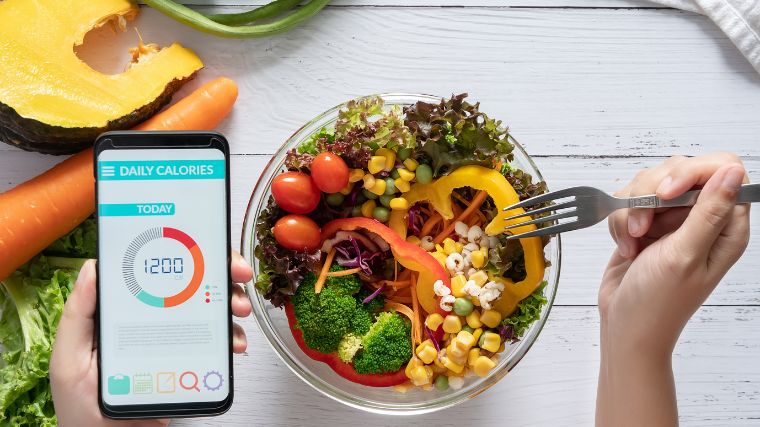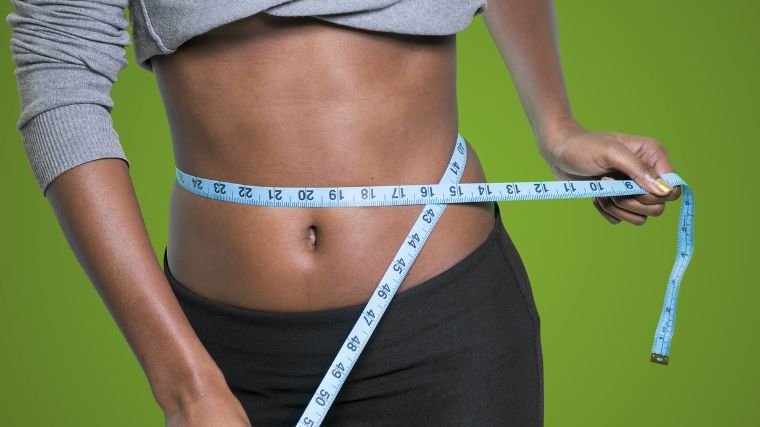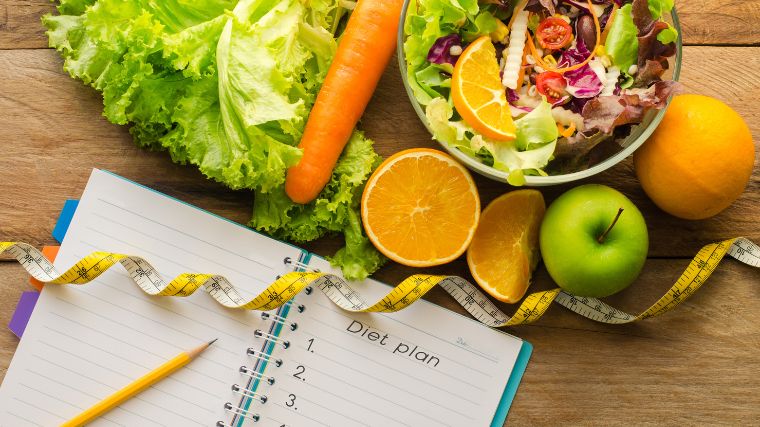The concept of a calorie deficit sounds simple: if you want to lose weight, eat less than your body needs to maintain its current weight. That doesn’t mean it’s easy, though, or that all methods of creating a deficit are equally safe and effective.
With all of the information — and misinformation — circulating, it’s a real challenge to figure out how to achieve a calorie deficit. It’s equally important to know how to do it safely, using methods that don’t sacrifice your health, performance, or overall quality of life.

You can think of intentional weight loss like a contact sport. It can be risky, especially if you throw caution to the wind and take extreme measures. You can mitigate potential harm by learning proper techniques and using protective gear (or, in this case, specific approaches).
Knowing the risks and benefits of calorie deficits will empower you to make an informed decision about whether reducing your calories for intentional weight loss is right for you, and how to go about it in the safest way.
Editor’s Note: The content on BarBend is meant to be informative in nature, but it should not be taken as medical advice. When starting a new training regimen and/or diet, it is always a good idea to consult with a trusted medical professional. We are not a medical resource. The opinions and articles on this site are not intended for use as diagnosis, prevention, and/or treatment of health problems. They are not substitutes for consulting a qualified medical professional.
What Is a Calorie Deficit?
Your body requires a certain amount of energy — measured in calories — to stay alive and perform all of your daily activities. The food you eat provides the energy your body needs. If you eat fewer calories than your body needs, you’re in a calorie deficit, or a negative energy balance, because you’re expending more than you’re taking in. (1)
When you’re in a calorie deficit, you lose weight because your body has to release the energy stored in your body fat in order to meet your energy needs. So, a calorie deficit is sometimes planned on purpose to cause intentional weight loss, but it can also be a side effect of any change in your lifestyle that puts you into an energy deficit. (1)
What Burns Calories?
Your body uses energy (often referred to as “burning calories”) constantly. The amount of energy you need to keep your organs functioning, digest and absorb nutrients, and engage in all of your physical activity is your total daily energy expenditure (TDEE). (1)
Your TDEE includes:
- Basal Metabolic Rate (BMR): The number of calories necessary to perform bodily functions, without any physical activity
- Thermic Effect of Food (TEF): The number of calories your body burns to digest and absorb nutrient from food
- Physical Activity: Any movement you perform, from getting out of bed to hitting the gym
Your BMR makes up the greatest portion of your TDEE. The TEF only makes up about 10-15 percent of your TDEE. Depending on your activity level, physical activity could make up a relatively small portion of your energy expenditure, or it could exceed your BMR. Your physical activity level is the only aspect of your TDEE that you have full control over. (1)
How to Achieve a Calorie Deficit
In the most basic terms, you achieve a calorie deficit by expending more calories than you ingest. You can do this by changing your diet to reduce your caloric intake, increasing your physical activity level (to increase your calorie expenditure), or a combination of both. (2)
Here’s the good news: you don’t need to follow a specific diet or spend hours in the gym to create a calorie deficit. In fact, you don’t even have to count macros or calories, necessarily. You can reduce your calorie intake by changing your food choices and using portion control without tracking or counting anything. (2)
Get More Physical Activity (In or Out of the Gym)
If you’ve been holding steady at your current weight for a while, you’ve been eating enough to maintain your body weight at your current activity level. If you don’t want to change the way you’re eating right away, it’s possible to create a deficit by simply increasing your physical activity, because that would increase your TDEE. (3)

[Read More: The Best Online Workout Programs For Coaching, Cardio, Value, And More]
You can increase your physical activity level by exercising, which provides benefits independent of weight loss, but you don’t have to follow an organized workout program. You can increase your energy expenditure with small changes, like taking the stairs, choosing distant parking spaces, or using a standing desk.
You can also move more and take short breaks for five to ten-minute “movement snacks” throughout the day if it’s hard to find a solid 30 minutes for a longer walk. (3)
Opt for Minimally-Processed Food (Most of the Time)
Reducing the amount you eat is one obvious way to eat fewer calories, but the foods that you choose can make a big difference in how quickly you eat and how full you feel after your meal.
Minimally-processed foods (think organic veggies, fresh poultry, or unrefined carbohydrates) are usually less calorie-dense than highly-processed foods and take up more room in your stomach, which helps you feel and stay full after a meal. Your body also burns more calories digesting these foods, but they aren’t broken down completely, which leaves some of the calories – perhaps up to about 170 per day – to be excreted in stool. (4)(5)
[Read More: The Best Healthy Fast Food Options at the Most Popular U.S. Chains]
Highly-processed foods, on the other hand, are easier to eat on the run, and despite being high in calories, they usually aren’t filling. That makes it harder to tell whether you’ve met or exceeded your energy needs if you’re eating them often. Because they’re easy to digest, they also provide more absorbable energy compared to less processed foods. (4)
Choose Less Energy Dense Food
You can also opt for lower-fat versions of the foods you’re already eating, like 93/7 beef instead of 85/15 beef or fat-free yogurt in place of regular yogurt. Even if you don’t reduce your portion sizes, replacing high-calorie foods with lower-calorie versions is a way to reduce the energy density of your diet. In other words, the same volume of food provides fewer calories. (6)
Energy dense (and even processed) foods like toaster pastries or granola can be useful for athletes that need quick sources of energy, so they still have their place even in a caloric deficit. Eat them in moderation — whether it’s for performance or enjoyment — and choose more minimally-processed foods for most of your meals. (6)
Use a Nutrition Tracker
One of the most common ways people create a calorie deficit is by tracking their calories or macros. That’s a straightforward, efficient way to achieve a deficit, much like using GPS to reach a destination.
If you’re never used a calorie calculator before, try BarBend’s intuitive, easy-to-use calculator:
Calorie Calculator
[Read More: 5 At-Home Workouts for Strength, Muscle Growth, Power, and More]
Though nutrition trackers can be extremely useful, it’s important to keep in mind that they could play a role in the development of disordered eating habits in some people (especially if they’re coupled with strict food rules and poor body image.) (7)(8) Nutritional tracking is a valuable tool, but shouldn’t be the entire framework of your relationship with food.
Ignore Your Fitness Tracker
Most wearable fitness gadgets like watches and rings will estimate your daily energy expenditure, but they’re rarely accurate. If you’ve been eating what should be a deficit based on your fitness tracker, but haven’t been losing weight, your device is probably overestimating your calories burned and you’re not in a calorie deficit. (9)
Benefits (and Drawbacks) of Caloric Deficits
A calorie deficit is necessary for fat loss, which can be useful or beneficial in certain cases, but it comes with some drawbacks, too. Keep these in mind when you’re considering whether cutting your calories is the best way to meet your goals.
You Could Gain a Competitive Advantage
If you’re a weight class or physique athlete, your body weight and body composition will make a huge difference in your performance. A caloric deficit is the only way to lose body fat, which could place you at the top of a lower weight class and give you an advantage over your competitors. Obviously, physique athletes need to reach extremely low levels of body fat to compete, which requires a caloric deficit. (10)

[Read More: Nutrition for Athletes — How to Eat for Muscle and Performance]
It’s possible to maintain or even increase strength while in a caloric deficit, which means it’s possible to change your strength-to-weight ratio, or how much you can lift in relation to your bodyweight. (11) This can be helpful across a wide range of sports, from powerlifting to gymnastics.
Your Health Could Improve
Losing fat via a caloric deficit could improve your health if you have certain conditions, like high blood pressure, high cholesterol, or prediabetes. While these conditions are influenced by a number of factors, including genetics, body fat plays a significant role in how they develop and progress. (12)
Your Health and Performance Could Suffer
If you’re already active and healthy with normal levels of body fat, it’s unlikely that a caloric deficit will improve your health. Remaining in a deficit that’s too large, or for too long, can actually have a negative impact on your health and performance. (10)
Relative energy deficiency in sport (RED-S) occurs when an athlete is in a calorie deficit long enough to disrupt their hormones, immune system, cardiovascular health, and bone density. In addition to the health consequences, they have lower aerobic capacity, their bodies are less responsive to training, and they don’t recover as well. This all translates to impaired performance in any sport or physical activity you might undertake. (10)
You Could Lose Muscle Mass
Although body recomposition — gaining muscle while losing fat — is possible, it becomes less likely with larger caloric deficits, especially for people who are already lean. If you already have low body fat or your deficit is greater than about 500 calories per day, you’re very likely going to lose some muscle mass. Obviously, this could affect both your performance and your health long-term. (11)
You Could Become More Preoccupied With Food
Even if you’re not in a calorie deficit, practicing restraint and controlling your intake can lead you to think about food more frequently. This is especially the case if you’re feeling deprived and hungry. This might not bother everyone, but it can certainly be an unpleasant distraction and unhelpful use of mental energy throughout the day. (10)
Weight Management Tips
Weight loss sounds simple, but that doesn’t mean it’s easy. Maintaining that weight loss is just as challenging: Longitudinal data shows that most people who lose weight will regain the majority of the lost weight (and sometimes more) within several years. (13)
A small percentage of people who pursue intentional weight loss – about 10 percent – are able to maintain their weight loss for over a year. The National Weight Control Registry collected information about successful weight loss maintainers to determine the most influential behaviors for weight loss maintenance. (12)(13)(14)

[Read More: The Complete Guide to Pre-Workout Supplements]
Before that, though, consider whether your goal weight is realistically sustainable, and to address the important psychological factors that can influence your long-term weight stability.
First, Make Sure Your Weight Is Actually Sustainable
People often feel pressure to maintain their new physique after losing weight. A leaner body is often seen as a sign of positive character traits, like willpower or self-discipline, while regaining weight is seen as failure. These beliefs can keep people stuck in the pursuit of a specific physique that might not be realistic for their circumstances. (15)(16)
Weight regulation doesn’t come down to willpower, though. Weight is controlled by a complex network of nerves and hormones that integrate signals from body fat, skeletal muscle, the digestive tract, and the brain. In some cases, these systems function to prevent weight loss and promote regain as a means of maintaining homeostasis. (13) Put simply, your body is generally resistant to significant changes (at least while they’re new).
[Read More: How Much Protein Do You Actually Need Per Day?]
That being said, sustainable weight loss is possible. There’s a big caveat here, though: your desired physique might not be sustainable for you if you need to sacrifice your health, social life, or performance to keep it.
Improve Your Body Image
Many people confuse liking their leaner physique with having an improved body image, and worry that regaining weight will worsen their body image, but this isn’t the case. Losing weight might make you less dissatisfied with your appearance, but that isn’t synonymous with a more positive or flexible body image. Your negative body image thoughts can return with weight regain. (15)(16)(17)(18)

[Read More: The Best Protein Intake Calculator for Muscle Gain and Fat Loss]
Contrary to a lot of the messaging on social media platforms, a negative body image doesn’t encourage people to build healthy habits. In fact, it’s associated with more weight cycling, or large fluctuations in body weight due to yo-yo dieting. Improving your body image could help you maintain a more stable, sustainable body weight. (15)(16)(17)(18)
Pay Attention to Your Body’s Cues
This might seem obvious, but many people have a hard time recognizing and responding to hunger or fullness. They might avoid hunger by grazing throughout the day or ignore it because they’re trying to control their food intake. They might ignore fullness because they’re enjoying an “off-limits” food that won’t be available later on. (18)(19)(20)(21)
Even if you’re tracking nutrition, hunger and fullness cues can provide you with useful information. For example, if you’re often eating in the absence of hunger or eating past fullness, it’s possible that your calorie calculator overestimated your needs, and your intake might need to be adjusted. (19)
Figure Out Your “Why”
You could also be eating for reasons other than hunger. It’s normal to eat purely for enjoyment at times, and food is more than just fuel; it’s a way to celebrate traditions, experience culture, and socialize. It can also be a source of comfort, but if you’re lacking other outlets — like social support, time to rest, and hobbies — you might find yourself eating to meet emotional needs. (22)
[Read More: The Best Foods for Energy Before, During, and After Your Workouts]
In some cases, people have built a habit of cleaning their plate because of their upbringing or because they’ve relied solely on counting macros or macro tracking to dictate how much they eat. In that case, the meal is finished when the plate is clean, regardless of how full (or hungry) they feel after eating. (19)(20)
Avoid Strict Diets
While strict diets often work initially, they’re often unsustainable long-term and can lead to yo-yo dieting. Rigid food rules, like making certain foods “off limits,” can lead to feeling out of control around certain foods. (18)(20)(21)
Excluding these foods creates more novelty and scarcity, which can lead to overeating because they seem irresistible when they’re available. Feelings of guilt and shame about “breaking the rules” can then lead to more restriction, and the cycle repeats. (18)(20)(21)

[Read More: The 13 Best Protein Powders]
According to the National Weight Control Registry, successful maintainers don’t restrict certain foods or have “cheat days.” Their diet on Saturday is similar to their diet on Tuesday. (13)(14) Flexible dieting is a fantastic way to bolster your chances of succeeding in significant weight change.
Stay Active (and Limit Screen Time)
So much of the conversation about weight management focuses on nutrition and calories, but the National Weight Control Registry reports that successful maintainers focus on more than nutrition.
They sustain high levels of physical activity and limit sedentary behaviors like watching television. By staying active, they expend a lot of calories each day, which means they have a larger energy budget when it comes to their calorie intake. (13)(14)
Summary
The conversations around calorie deficits and weight loss are changing, and the conflicting information can be confusing. There’s no conclusion or approach that will be right for everyone, but the reality is that people still want to know how to lose weight.
You can think of weight loss practices like contact sports, because they do come with unavoidable risks, but you can mitigate potential harm by using protective gear (or, in this case, specific approaches).
By acknowledging the complexity and difficulty of weight regulation — as well as the risks of pursuing a specific weight or physique — you can set more realistic expectations about your long-term weight stability and avoid harmful fads that can keep you stuck in a cycle of yo-yo dieting.
FAQs
The math behind calories might be simple, but maintaining a calorie deficit isn’t always straightforward. Here are some common questions you might have, along with evidence-based answers.
How do I figure out my calorie deficit?
It’s commonly recommended to aim for a 250 to 500 calorie deficit each day, which would lead to losing about ½ to 1 pound per week. You can start with an online calculator or a nutrition tracking app to estimate your calorie needs, but keep in mind that those can be pretty inaccurate. You might need to adjust your intake based on how your actual rate of loss compares to what you expect based on your calculations.
A larger deficit can help you reach your weight goal faster, but it’s also more likely to limit your performance and leave you feeling hungrier and more fatigued. A smaller deficit could be less intrusive and more sustainable, but it also leaves you with less room for error, and extends the time you’ll need to spend in a deficit.
How many calories should I eat during a calorie deficit?
Once you’ve decided on the size of your calorie deficit, you subtract that from your estimated maintenance calorie needs to figure out how many calories to eat for weight loss. Calorie calculators are one place to start, but they can be pretty inaccurate. It’s important to pay attention to how your body is responding and changing to fine tune your intake.
How to know if I’m in a calorie deficit?
When you’re in a calorie deficit, your body will quickly begin to send signals to increase your food intake and reduce your energy expenditure. So, you might notice more hunger and fatigue. These aren’t always indicative of an energy deficit, but they’re useful cues.
If you’re noticing gradual weight loss over the course of a few weeks, you’re likely in a calorie deficit. Since weight can fluctuate by several pounds over the course of the day due to changes in hydration and food intake, you shouldn’t interpret the change from one day to the next as a sign of progress.
Instead, consider weighing yourself two to three times a week and calculating the average, then compare your weekly averages. Or, choose an article of clothing as your reference and track how that fits over time. You could also take circumference measurements of your arm, waist, hip, and thigh to track changes in those areas.
Is my calorie deficit too high?
It might be tempting to cut your calories as low as possible to fast-track your weight loss, but this short-term fix is simply not worth the risk. Your calorie deficit is probably too high if you notice that you’re tired all the time, you aren’t sleeping well, you’re constantly hungry (or even hangry), you can’t focus on anything (except for your next meal), your performance is suffering, and you aren’t recovering well between workouts.
Is a calorie deficit a good way to lose weight?
You can lose body weight quickly via dehydration or after an overnight fast, but that short-term weight loss isn’t the same thing as fat loss (and it can be dangerous). Despite what you might hear from some influencers that claim calories don’t matter, a calorie deficit is the only way to lose body fat. There are no special diets or foods that cause fat loss, and any way of eating that leads to fat loss does so because it creates a calorie deficit.
References
- Westerterp K. R. (2018). Exercise, energy expenditure and energy balance, as measured with doubly labelled water. The Proceedings of the Nutrition Society, 77(1), 4–10.
- Ge, L., Sadeghirad, B., Ball, G. D. C., da Costa, B. R., Hitchcock, C. L., Svendrovski, A., Kiflen, R., Quadri, K., Kwon, H. Y., Karamouzian, M., Adams-Webber, T., Ahmed, W., Damanhoury, S., Zeraatkar, D., Nikolakopoulou, A., Tsuyuki, R. T., Tian, J., Yang, K., Guyatt, G. H., & Johnston, B. C. (2020). Comparison of dietary macronutrient patterns of 14 popular named dietary programmes for weight and cardiovascular risk factor reduction in adults: systematic review and network meta-analysis of randomised trials. BMJ (Clinical research ed.), 369, m696.
- Wang, S., Zhou, H., Zhao, C., & He, H. (2022). Effect of Exercise Training on Body Composition and Inflammatory Cytokine Levels in Overweight and Obese Individuals: A Systematic Review and Network Meta-Analysis. Frontiers in immunology, 13, 921085.
- Hall, K. D., Ayuketah, A., Brychta, R., Cai, H., Cassimatis, T., Chen, K. Y., Chung, S. T., Costa, E., Courville, A., Darcey, V., Fletcher, L. A., Forde, C. G., Gharib, A. M., Guo, J., Howard, R., Joseph, P. V., McGehee, S., Ouwerkerk, R., Raisinger, K., Rozga, I., … Zhou, M. (2019). Ultra-Processed Diets Cause Excess Calorie Intake and Weight Gain: An Inpatient Randomized Controlled Trial of Ad Libitum Food Intake. Cell metabolism, 30(1), 67–77.e3.
- Corbin, K. D., Carnero, E. A., Dirks, B., Igudesman, D., Yi, F., Marcus, A., Davis, T. L., Pratley, R. E., Rittmann, B. E., Krajmalnik-Brown, R., & Smith, S. R. (2023). Host-diet-gut microbiome interactions influence human energy balance: a randomized clinical trial. Nature communications, 14(1), 3161.
- Pérez-Escamilla, R., Obbagy, J. E., Altman, J. M., Essery, E. V., McGrane, M. M., Wong, Y. P., Spahn, J. M., & Williams, C. L. (2012). Dietary energy density and body weight in adults and children: a systematic review. Journal of the Academy of Nutrition and Dietetics, 112(5), 671–684.
- Simpson, C. C., & Mazzeo, S. E. (2017). Calorie counting and fitness tracking technology: Associations with eating disorder symptomatology. Eating behaviors, 26, 89–92.
- Linardon, J., & Messer, M. (2019). My fitness pal usage in men: Associations with eating disorder symptoms and psychosocial impairment. Eating behaviors, 33, 13–17.
- Fuller, D., Colwell, E., Low, J., Orychock, K., Tobin, M. A., Simango, B., Buote, R., Van Heerden, D., Luan, H., Cullen, K., Slade, L., & Taylor, N. G. A. (2020). Reliability and Validity of Commercially Available Wearable Devices for Measuring Steps, Energy Expenditure, and Heart Rate: Systematic Review. JMIR mHealth and uHealth, 8(9), e18694.
- Helms, E. R., Prnjak, K., & Linardon, J. (2019). Towards a Sustainable Nutrition Paradigm in Physique Sport: A Narrative Review. Sports (Basel, Switzerland), 7(7), 172.
- Barakat, C. M. S., Pearson, J. M., Escalante, G. D., Campbell, B. P., & De Souza, E. O. (2020). Body recomposition: Can trained individuals build muscle and lose fat at the same time?. Strength and Conditioning Journal, 42(5), 7-21.
- Hall, K. D., & Kahan, S. (2018). Maintenance of Lost Weight and Long-Term Management of Obesity. The Medical clinics of North America, 102(1), 183–197.
- Ogden, L. G., Stroebele, N., Wyatt, H. R., Catenacci, V. A., Peters, J. C., Stuht, J., Wing, R. R., & Hill, J. O. (2012). Cluster analysis of the national weight control registry to identify distinct subgroups maintaining successful weight loss. Obesity, 20(10), 2039–2047.
- Flore, G., Preti, A., Carta, M. G., Deledda, A., Fosci, M., Nardi, A. E., Loviselli, A., & Velluzzi, F. (2022). Weight Maintenance after Dietary Weight Loss: Systematic Review and Meta-Analysis on the Effectiveness of Behavioural Intensive Intervention. Nutrients, 14(6).
- Reinka, M. A., Quinn, D. M., & Puhl, R. M. (2021). Examining the relationship between weight controllability beliefs and eating behaviors: The role of internalized weight stigma and BMI. Appetite, 164(April), 105257.
- Murakami, J. M., & Latner, J. D. (2015). Weight acceptance versus body dissatisfaction: Effects on stigma, perceived self-esteem, and perceived psychopathology. Eating Behaviors, 19, 163–167.
- Rahimi-Ardabili, H., Reynolds, R., Vartanian, L. R., McLeod, L. V. D., & Zwar, N. (2018). A Systematic Review of the Efficacy of Interventions that Aim to Increase Self-Compassion on Nutrition Habits, Eating Behaviours, Body Weight and Body Image. Mindfulness, 9(2), 388–400.
- Linardon, J., & Mitchell, S. (2017). Rigid dietary control, flexible dietary control, and intuitive eating: Evidence for their differential relationship to disordered eating and body image concerns. Eating behaviors, 26, 16–22.
- Ciampolini, M., Lovell-Smith, H. D., Kenealy, T., & Bianchi, R. (2013). Hunger can be taught: Hunger Recognition regulates eating and improves energy balance. International journal of general medicine, 6, 465–478.
- Epstein, L. H., Temple, J. L., Roemmich, J. N., & Bouton, M. E. (2009). Habituation as a determinant of human food intake. Psychological review, 116(2), 384–407.
- Schaumberg, K., Anderson, D. A., Anderson, L. M., Reilly, E. E., & Gorrell, S. (2016). Dietary restraint: what’s the harm? A review of the relationship between dietary restraint, weight trajectory and the development of eating pathology. Clinical obesity, 6(2), 89–100.
- Guerrero-Hreins, E., Stammers, L., Wong, L., Brown, R. M., & Sumithran, P. (2022). A Comparison of Emotional Triggers for Eating in Men and Women with Obesity. Nutrients, 14(19), 4144.
Featured Image: asiandelight / Shutterstock